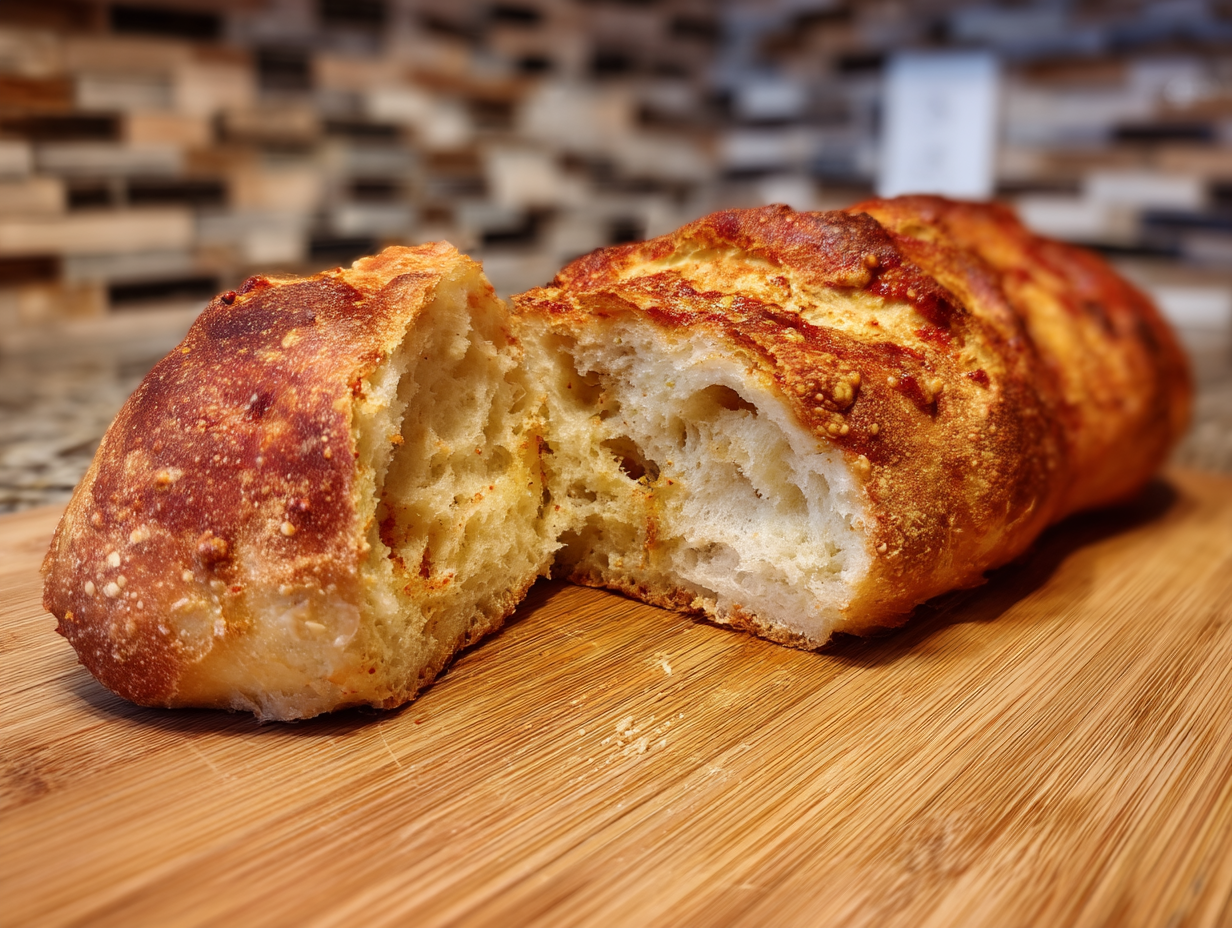There’s nothing quite like the smell of freshly baked bread filling your kitchen. If you’ve ever wanted to master an Italian bread recipe, you’re in the right place. This guide will teach you how to bake authentic, crusty Italian bread at home using simple ingredients and easy steps.
Whether you’re a beginner or a seasoned baker, this Italian bread recipe will help you create a loaf with a crispy crust and soft, airy interior—just like the ones from an Italian bakery. Let’s get started!
Table of Contents
Introduction to Italian Bread
What Makes Italian Bread Unique?
Italian bread is more than just a staple—it’s a cultural icon. Unlike other breads, it’s known for its crusty exterior and soft, airy interior. What sets it apart is its simplicity. Traditional Italian bread recipes rely on just a handful of ingredients: flour, water, yeast, and salt. No fancy additives, no complicated steps—just pure, wholesome goodness.
Historically, Italian bread has been a symbol of community and tradition. Each region in Italy has its own variation, from the iconic ciabatta of Lombardy to the rustic pagnotta found in rural villages. These breads are often baked in communal ovens, bringing people together in a shared love for good food.
Why You Should Try This Italian Bread Recipe
If you’ve never baked bread before, an Italian bread recipe is a fantastic place to start. It’s straightforward, forgiving, and incredibly rewarding. Plus, there’s nothing quite like the satisfaction of pulling a golden, fragrant loaf out of your own oven.
Homemade bread also has health benefits. Unlike store-bought versions, you control the ingredients, ensuring there are no preservatives or artificial additives. And let’s be honest—nothing beats the taste of fresh bread, still warm from the oven, slathered with butter or dipped in olive oil.
So, whether you’re looking to impress your family, explore a new hobby, or simply enjoy the process of baking, this Italian bread recipe is your ticket to delicious success.
Essential Ingredients for Authentic Italian Bread
The Best Flour for Italian Bread
When it comes to an Italian bread recipe, the flour you choose can make or break your loaf. Traditionally, Tipo 00 flour is the gold standard. This finely milled flour creates a soft, elastic dough that’s perfect for achieving that signature crusty exterior and airy interior. However, if you can’t find Tipo 00, don’t worry—all-purpose flour or bread flour works well too. Bread flour, with its higher protein content, gives the dough extra strength, while all-purpose flour offers a more neutral flavor.
The Role of Water, Yeast, and Salt
Next up, let’s talk about the other key players in your Italian bread recipe. Water might seem like a no-brainer, but its temperature matters. Too cold, and the yeast won’t activate; too hot, and you’ll kill it. Aim for lukewarm water—around 105°F to 110°F—to get the yeast going.
Speaking of yeast, you have options. Fresh yeast, dry yeast, or even a sourdough starter can be used. Dry yeast is the most convenient and widely available, but if you’re feeling adventurous, a sourdough starter adds a tangy depth of flavor.
Salt, on the other hand, isn’t just for taste. It strengthens the dough and controls yeast activity, ensuring your bread rises perfectly. Use fine sea salt for even distribution.
Optional Add-Ins for Flavor Variations
While traditional Italian bread recipes stick to the basics, there’s room to get creative. Add-ins like rosemary, olives, or sun-dried tomatoes can elevate your loaf to new heights. For a nutty twist, try incorporating sesame seeds or walnuts. These additions not only enhance flavor but also make your bread visually appealing.
Step-by-Step Italian Bread Recipe
Preparing the Dough

To start your Italian bread recipe, combine your flour, yeast, and salt in a large mixing bowl. Gradually add warm water while stirring until a shaggy dough forms. Don’t worry if it looks messy—this is just the beginning.
Next, it’s time to knead. Turn the dough onto a lightly floured surface and work it with your hands for about 10 minutes. The goal is to develop gluten, which gives the bread its structure. If the dough feels too sticky, add a bit more flour, but be careful not to overdo it. You’re aiming for a smooth, elastic dough that springs back when poked.
First Rise: Letting the Dough Ferment
Once your dough is kneaded, place it in a lightly oiled bowl, cover it with a damp cloth, and let it rise. This is where the magic happens. The yeast ferments, creating air pockets that will give your bread its airy interior. Let the dough rest in a warm, draft-free spot for about 1 to 1.5 hours, or until it doubles in size.
Shaping the Italian Bread
After the first rise, gently punch down the dough to release any air bubbles. Now, it’s time to shape it. For a classic filone (long loaf), roll the dough into an oval shape. If you prefer a round pagnotta, shape it into a ball. Place the shaped dough on a baking sheet lined with parchment paper.
Second Rise: Final Proofing
Cover the shaped dough with a damp cloth and let it rise again for about 30 to 45 minutes. This second rise, or proofing, ensures your bread bakes up light and fluffy. While the dough rests, preheat your oven to 450°F (230°C). If you have a baking stone or Dutch oven, now’s the time to use it—they help create that perfect crusty exterior.
Baking the Perfect Italian Bread
Before baking, score the top of the dough with a sharp knife or razor blade. This allows the bread to expand evenly in the oven. If you’re using a baking stone, transfer the dough onto it carefully. For a crispy crust, add steam to the oven by placing a pan of hot water on the bottom rack or spritzing the dough with water.
Bake for 25 to 30 minutes, or until the bread is golden brown and sounds hollow when tapped on the bottom. Let it cool on a wire rack before slicing.
Tips and Tricks for Perfect Italian Bread
How to Achieve a Crispy Crust
One of the hallmarks of a great Italian bread recipe is its crispy crust. To achieve this, steam is your best friend. When you bake, the steam keeps the dough’s surface moist, allowing it to expand before forming a crust. You can create steam by placing a pan of hot water on the oven’s bottom rack or spritzing the dough with water before baking.
Another trick is to use a baking stone or Dutch oven. These tools retain heat and mimic the effects of a professional bread oven. Preheat them along with your oven, and you’ll get a crust that’s golden and crackly every time.
Storing and Reviving Italian Bread
Freshly baked Italian bread is best enjoyed the same day, but if you have leftovers, don’t worry. To keep it fresh, store it in a paper bag at room temperature for up to two days. Avoid plastic bags, as they trap moisture and make the crust soggy.
If your bread has gone stale, you can bring it back to life. Simply sprinkle it with water and pop it in a 350°F (175°C) oven for 5 to 10 minutes. This will make your Italian bread crispy again, almost like it’s fresh out of the oven.
Common Mistakes to Avoid
Even the best bakers make mistakes, but knowing what to watch out for can save your Italian bread recipe. Overproofing is a common issue—it happens when the dough rises too much, causing it to collapse in the oven. To avoid this, keep an eye on the dough during proofing and bake it as soon as it doubles in size.
Another pitfall is under-kneading. If the dough isn’t kneaded enough, it won’t develop enough gluten, resulting in a dense loaf. On the flip side, over-kneading can make the bread tough. Aim for a smooth, elastic dough that springs back when poked.
Variations of Italian Bread Recipes
Classic Italian Ciabatta Recipe
If you’re looking to expand your bread-making skills, try making ciabatta. This Italian favorite is known for its irregular holes and chewy texture. The dough is wetter than traditional Italian bread recipes, which gives it its unique structure.
Whole Wheat Italian Bread
For a healthier twist, swap out some of the white flour for whole wheat. This adds a nutty flavor and boosts the bread’s fiber content. Keep in mind that whole wheat flour absorbs more water, so you may need to adjust the hydration level of your dough.
Gluten-Free Italian Bread Options
If you’re avoiding gluten, you can still enjoy Italian bread. Use a gluten-free flour blend and add xanthan gum to mimic the texture of gluten. While the result won’t be exactly the same, it’s a delicious alternative for those with dietary restrictions.
Serving and Pairing Italian Bread
Traditional Ways to Serve Italian Bread

Once you’ve mastered your Italian bread recipe, it’s time to enjoy it! One of the simplest and most traditional ways to serve Italian bread is with a drizzle of extra virgin olive oil and a splash of balsamic vinegar. This combination highlights the bread’s flavor and adds a touch of richness.
Another classic option is to use it as a side for soups and stews. The bread’s crusty exterior is perfect for soaking up broths and sauces, making every bite a delight. For a quick snack, slice the bread, toast it lightly, and top it with fresh tomatoes, basil, and a sprinkle of salt for a rustic bruschetta.
Perfect Pairings for Italian Bread
Italian bread pairs beautifully with a variety of dishes. Serve it alongside pasta dishes like spaghetti carbonara or lasagna to complete your meal. It also complements salads, especially those with bold flavors like a classic Caprese salad.
For a heartier option, use your Italian bread recipe to make sandwiches. Fill it with cured meats, cheeses, and fresh veggies for a satisfying lunch. The bread’s sturdy texture holds up well, even with the juiciest fillings.
FAQs About Italian Bread
What Makes Italian Bread Different?
Italian bread stands out because of its crusty exterior and soft, airy interior. Unlike other breads, it’s made with simple ingredients—flour, water, yeast, and salt—and often baked in a way that creates a crisp crust and chewy texture.
What Is the Best Flour to Use for Italian Bread?
The best flour for an Italian bread recipe is Tipo 00 flour, which is finely milled and perfect for creating a soft, elastic dough. If you can’t find it, bread flour or all-purpose flour works well too.
What Is the Most Popular Bread in Italy?
Italy is home to many beloved breads, but ciabatta and focaccia are among the most popular. Ciabatta is known for its irregular holes and chewy texture, while focaccia is a flatbread often topped with olive oil and herbs.
How to Make Italian Bread Crispy Again?
To revive stale Italian bread, sprinkle it with water and bake it at 350°F (175°C) for 5 to 10 minutes. This will restore its crispy crust and make it taste fresh again.
And there you have it—a complete guide to mastering your Italian bread recipe! From ingredients and techniques to serving ideas and FAQs, you’re now equipped to bake bread that’s as delicious as it is authentic. Happy baking!

